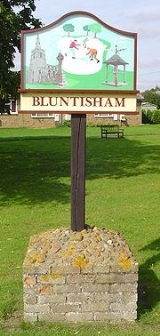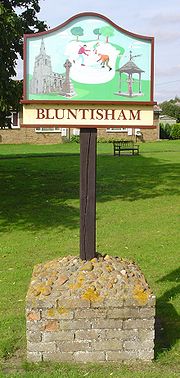
Bluntisham
Encyclopedia
Bluntisham is a village
in the Huntingdonshire
district of Cambridgeshire
), England
. It is near Earith
east of St Ives.
The Prime Meridian
passes through the western edge of Bluntisham.
Also known as Bluntisham-cum-Earith
Bluntersham (x - xiii cent.), Blondesham (xiv cent.), Bluntysham, Bluntsome, Blunsham (xvi cent.).
Herhythe, Herhethe (xii cent.), Herethe, Erehethe, Erhuth (xiv cent.), Earette, Earythe (xvi cent.).

The two townships of Bluntisham and Earith, which are one mile (1.6 km) apart, have probably always formed one ecclesiastical parish with the parish church in Bluntisham and a chapelry in Earith. The usual ecclesiastical name is Bluntisham-cum-Earith. The soil varies: in the gravel areas, fruit trees, barley and oats do well whilst on the loam and clay lands wheat prevails. The water supply traditionally was derived from gravel springs in places; later wells, fed by surface water (called 'sock' wells) were used. On the west, near the Somersham road, was a chalybeate spring where more than one attempt was made in the 18th century to establish a Spa (known as Somersham Spa).
Evidence of Neolithic and Roman inhabitants has been found. However, the four open fields of the old village can still be traced. Higham Field lay in the north-western part of the parish - about 100 ft (30.5 m). above sea-level. Gill Field in the south-western part, which gradually slopes down to the River Ouse, takes its name from the 'Gills' or water channels. From Higham Field eastwards, on the north side was Coleway Field, and between that and Bury Fen (which lies below the church) was Old Mill Field or Inhams, which stretched from Bluntisham to Earith.
The once quite considerable woodland has almost disappeared. In 1843, there still was 68 acres (275,186.5 m²) of woodland but this had reduced to only 10 acres (40,468.6 m²) by 1925, leaving only their names.
The west end of the parish was part of Somersham Heath, which was enclosed in 1797. There was no road across it before then. This part of the parish is still called Bluntisham Heath. The western end of the village is called Wood End; eastwards was the Colne road where some of the oldest buildings were located. The main part of Bluntisham Village runs straight north and south to the Rectory Corner on the St. Ives road. At this point stood the village pound and a small hamlet known as Little London.
Earith means 'mud' (or more probably gravel) and hithe means a landing place. Earith has always had an important distinction from Bluntisham because of its proximity to the river. The village lies chiefly along the road coming from Earith Bridge towards St. Ives. Many Quakers had their homes in Earith after 1650, and a Meeting House has existed there since.
The Earith bridge has always been important. As early as 1346, the local community complained to Parliament that this bridge, which had been used from ancient times, was entirely gone for default of repair. A bridge and causeway (known as 'Earith Causey') over Haddenham Fen were looked after by hermits in the 14th and 15th centuries, and indulgences were granted around 1400 for the repairs and maintenance. This bridge was still in existence in 1637. A new bridge over the old Bedford River was erected in 1812, and a further cast-iron one was put over the new Bedford River in 1826.
The civil parish of Bluntisham-cum-Earith was dissolved in 1948 when two separate civil parishes of Bluntisham and Earith were formed.
Bluntisham's most famous denizen is probably Dorothy L. Sayers
, the popular crime writer. She lived in the village from 1897, when her father became the rector, to 1917. Her novel The Nine Tailors
was inspired by her father's restoration of the Bluntisham church bells in 1910. They can also boast to have the most successful Bandy
club in British history, the Bury Fen bandy club. From this infamous club came Charles G Tebbutt, who was responsible for the first published rules of Bandy in 1882.
Bluntisham's Facilities -
Bluntisham now has more facilities than it did a few years ago including a new Budgens store, Village Hall and opening soon in April a Hair & Beuty Salon and a coffee lounge. There also may be a village barbers as well. There are regular buses to St Ives operate by both Stagecoach and local company Go Whippet.
moved to Bluntisham when she was eight years old. Wright now resides in Birmingham.
Village
A village is a clustered human settlement or community, larger than a hamlet with the population ranging from a few hundred to a few thousand , Though often located in rural areas, the term urban village is also applied to certain urban neighbourhoods, such as the West Village in Manhattan, New...
in the Huntingdonshire
Huntingdonshire
Huntingdonshire is a local government district of Cambridgeshire, covering the area around Huntingdon. Traditionally it is a county in its own right...
district of Cambridgeshire
Cambridgeshire
Cambridgeshire is a county in England, bordering Lincolnshire to the north, Norfolk to the northeast, Suffolk to the east, Essex and Hertfordshire to the south, and Bedfordshire and Northamptonshire to the west...
), England
England
England is a country that is part of the United Kingdom. It shares land borders with Scotland to the north and Wales to the west; the Irish Sea is to the north west, the Celtic Sea to the south west, with the North Sea to the east and the English Channel to the south separating it from continental...
. It is near Earith
Earith
Earith is a village in the Fens of Cambridgeshire, England, south of Chatteris and east of Huntingdon. At Earith, two artificial diversion channels of the River Great Ouse, the Old Bedford River and the New Bedford River, leave the river on a course to Denver Sluice near Downham Market, where they...
east of St Ives.
The Prime Meridian
Prime Meridian
The Prime Meridian is the meridian at which the longitude is defined to be 0°.The Prime Meridian and its opposite the 180th meridian , which the International Date Line generally follows, form a great circle that divides the Earth into the Eastern and Western Hemispheres.An international...
passes through the western edge of Bluntisham.
Also known as Bluntisham-cum-Earith
Bluntersham (x - xiii cent.), Blondesham (xiv cent.), Bluntysham, Bluntsome, Blunsham (xvi cent.).
Herhythe, Herhethe (xii cent.), Herethe, Erehethe, Erhuth (xiv cent.), Earette, Earythe (xvi cent.).

The two townships of Bluntisham and Earith, which are one mile (1.6 km) apart, have probably always formed one ecclesiastical parish with the parish church in Bluntisham and a chapelry in Earith. The usual ecclesiastical name is Bluntisham-cum-Earith. The soil varies: in the gravel areas, fruit trees, barley and oats do well whilst on the loam and clay lands wheat prevails. The water supply traditionally was derived from gravel springs in places; later wells, fed by surface water (called 'sock' wells) were used. On the west, near the Somersham road, was a chalybeate spring where more than one attempt was made in the 18th century to establish a Spa (known as Somersham Spa).
Evidence of Neolithic and Roman inhabitants has been found. However, the four open fields of the old village can still be traced. Higham Field lay in the north-western part of the parish - about 100 ft (30.5 m). above sea-level. Gill Field in the south-western part, which gradually slopes down to the River Ouse, takes its name from the 'Gills' or water channels. From Higham Field eastwards, on the north side was Coleway Field, and between that and Bury Fen (which lies below the church) was Old Mill Field or Inhams, which stretched from Bluntisham to Earith.
The once quite considerable woodland has almost disappeared. In 1843, there still was 68 acres (275,186.5 m²) of woodland but this had reduced to only 10 acres (40,468.6 m²) by 1925, leaving only their names.
The west end of the parish was part of Somersham Heath, which was enclosed in 1797. There was no road across it before then. This part of the parish is still called Bluntisham Heath. The western end of the village is called Wood End; eastwards was the Colne road where some of the oldest buildings were located. The main part of Bluntisham Village runs straight north and south to the Rectory Corner on the St. Ives road. At this point stood the village pound and a small hamlet known as Little London.
Earith means 'mud' (or more probably gravel) and hithe means a landing place. Earith has always had an important distinction from Bluntisham because of its proximity to the river. The village lies chiefly along the road coming from Earith Bridge towards St. Ives. Many Quakers had their homes in Earith after 1650, and a Meeting House has existed there since.
The Earith bridge has always been important. As early as 1346, the local community complained to Parliament that this bridge, which had been used from ancient times, was entirely gone for default of repair. A bridge and causeway (known as 'Earith Causey') over Haddenham Fen were looked after by hermits in the 14th and 15th centuries, and indulgences were granted around 1400 for the repairs and maintenance. This bridge was still in existence in 1637. A new bridge over the old Bedford River was erected in 1812, and a further cast-iron one was put over the new Bedford River in 1826.
The civil parish of Bluntisham-cum-Earith was dissolved in 1948 when two separate civil parishes of Bluntisham and Earith were formed.
Bluntisham's most famous denizen is probably Dorothy L. Sayers
Dorothy L. Sayers
Dorothy Leigh Sayers was a renowned English crime writer, poet, playwright, essayist, translator and Christian humanist. She was also a student of classical and modern languages...
, the popular crime writer. She lived in the village from 1897, when her father became the rector, to 1917. Her novel The Nine Tailors
The Nine Tailors
The Nine Tailors is a 1934 mystery novel by British writer Dorothy L. Sayers, her ninth featuring sleuth Lord Peter Wimsey.- Plot introduction :For this novel, set in the Fens, Sayers had to learn about change ringing...
was inspired by her father's restoration of the Bluntisham church bells in 1910. They can also boast to have the most successful Bandy
Bandy
Bandy is a team winter sport played on ice, in which skaters use sticks to direct a ball into the opposing team's goal.The rules of the game have many similarities to those of association football: the game is played on a rectangle of ice the same size as a football field. Each team has 11 players,...
club in British history, the Bury Fen bandy club. From this infamous club came Charles G Tebbutt, who was responsible for the first published rules of Bandy in 1882.
Bluntisham's Facilities -
Bluntisham now has more facilities than it did a few years ago including a new Budgens store, Village Hall and opening soon in April a Hair & Beuty Salon and a coffee lounge. There also may be a village barbers as well. There are regular buses to St Ives operate by both Stagecoach and local company Go Whippet.
Notable residents
British artist Annemarie WrightAnnemarie Wright
Annemarie Wright is an artist from Cambridgeshire, England. She is best known for her portrait of Tony Blair created using the handwritten names of fallen British soldiers from Iraq and Afghanistan, titled Their families have been told....
moved to Bluntisham when she was eight years old. Wright now resides in Birmingham.

